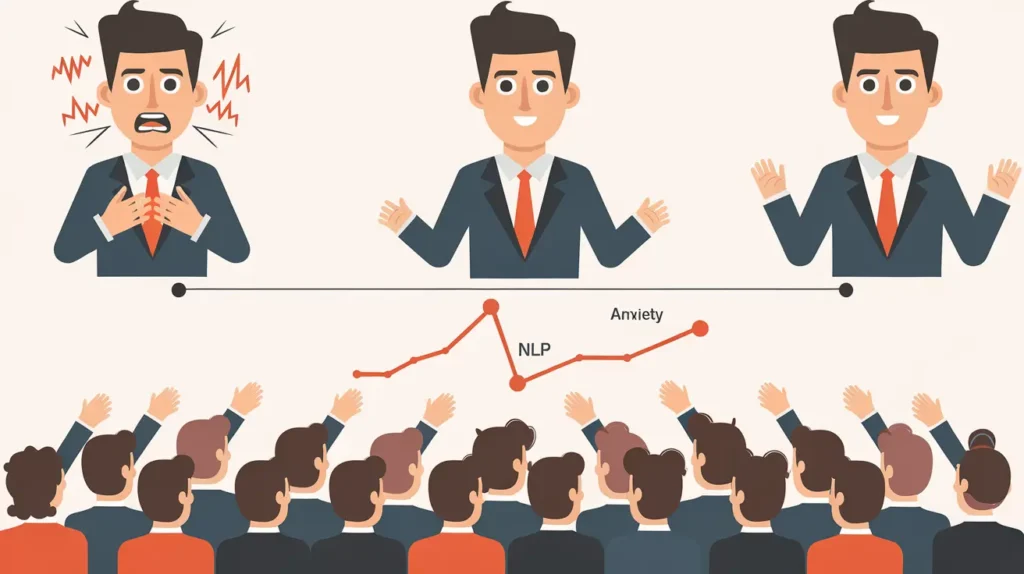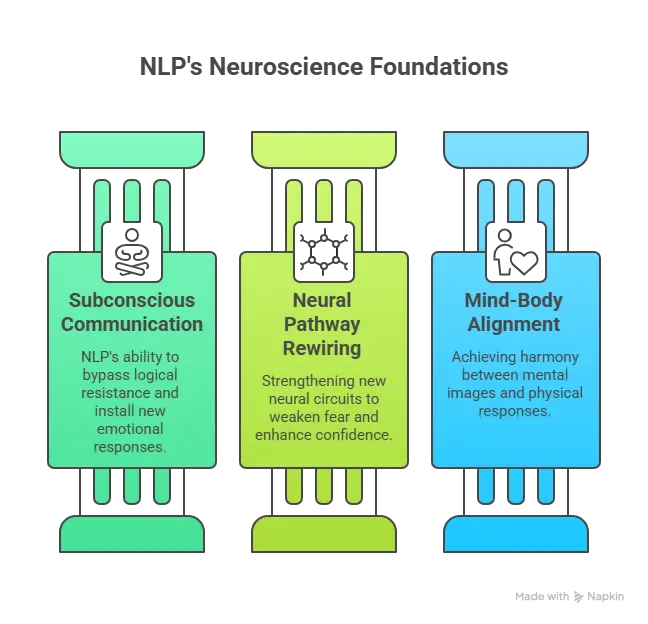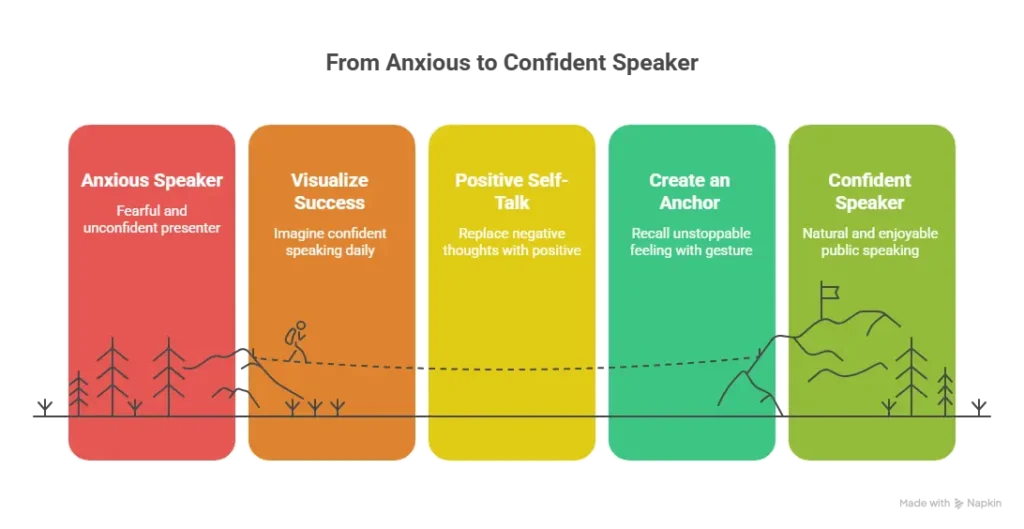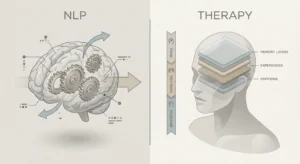Public speaking anxiety fades with NLP (Neuro-Linguistic Programming) because it directly retrains your subconscious mind the place where fear lives. By using techniques such as Reframing, Anchoring, The Swish Pattern, and Future Pacing, NLP changes negative thought patterns, builds emotional control, and programs your mind to associate public speaking with confidence, connection, and clarity instead of fear.
If your heart races at the thought of standing before an audience, you’re not alone. Studies show that over 75% of people experience some form of public speaking anxiety.
But here’s something most people don’t realize the fear of public speaking isn’t logical. It’s neurological.
Your subconscious mind interprets public speaking as a “threat,” triggering a fight-or-flight response sweaty palms, dry throat, trembling voice. You may know your topic inside out, yet the body seems to betray you.
That’s where Neuro-Linguistic Programming (NLP) steps in. NLP isn’t about memorizing speeches or suppressing nerves. It’s about rewiring how your brain perceives the experience of speaking in public. When you shift your internal response, your external confidence naturally follows.
In this guide, we’ll break down exactly how NLP achieves that transformation and why its results are lasting, not temporary.
Key Takeaways
- NLP targets the root cause of anxiety subconscious fear patterns instead of surface symptoms.
- It transforms nervousness into energy and clarity through reframing and mental reprogramming.
- NLP creates new neural pathways, linking public speaking with confidence, not threat.
- With consistent use, NLP turns temporary calm into a permanent internal state of composure.
- The result: You stop “managing” fear and start enjoying public speaking.
Why Public Speaking Feels So Overwhelming

If your heart races at the thought of facing an audience, you’re not alone nearly 75% of people feel the same. But here’s the twist: your fear isn’t logical; it’s neurological.
Your brain perceives public speaking as a survival threat, triggering the fight-or-flight response. Suddenly, your body acts as if it’s escaping danger your throat tightens, palms sweat, and mind blanks.
You may know your topic well, but your physiology doesn’t cooperate. Traditional advice like “just relax” or “imagine the audience naked” doesn’t touch the deeper issue.
That’s where Neuro-Linguistic Programming (NLP) steps in because it speaks the language of the subconscious mind, not just the conscious one.
Why NLP Works When Traditional Methods Don’t
Most speaking advice focuses on technique how to stand, speak, or gesture.
NLP focuses on transformation changing how your brain perceives the experience itself.
Instead of forcing confidence, NLP helps you feel confident by rewiring the emotional triggers associated with fear.
In short: traditional methods teach you what to do. NLP changes how you feel while doing it.
Why NLP Fades Public Speaking Anxiety Step by Step
1. NLP Reprograms the Fear Response
Public speaking anxiety is often a learned emotional association. Somewhere, your brain linked being seen or judged with rejection or danger. NLP helps unlearn that.
By altering submodalities (the visual and sensory “coding” of a memory), NLP changes how you store and recall the speaking experience. For instance, making your mental image of the audience smaller, brighter, and more encouraging shifts your emotional state from fear to calm engagement.
The brain learns through repetition and NLP gives it a new script.
2. Reframing: Turning Fear into Excitement
Reframing changes the meaning you assign to your sensations. A fast heartbeat can mean “I’m scared,” or it can mean “I’m energized.”
Through NLP, speakers learn to reinterpret nervous signals as readiness. Instead of battling fear, you redirect that adrenaline into enthusiasm transforming anxiety into performance energy.
Perception determines experience. Reframe it, and your entire state changes.
3. Anchoring: Creating Instant Calm

Anchoring links a physical gesture like pressing your thumb and forefinger together with a powerful emotional state (confidence, calm, or excitement).
When repeated, your brain associates that touch with the positive feeling. Before you step on stage, activating your anchor triggers that emotion instantly no matter the crowd size.
It’s a psychological shortcut to calmness and composure.
4. The Swish Pattern: Rewriting the Fear Movie
If your mind keeps replaying images of embarrassment or failure, the Swish Pattern interrupts and replaces them with empowering visuals.
You “swish” the negative image out and bring in one where you speak smoothly, smile confidently, and see your audience engaged.
Repeat it enough, and the subconscious starts projecting the new movie automatically one where you perform your best.
5. Future Pacing: Programming Confidence Ahead of Time
Future Pacing helps you mentally experience success before it happens.
You vividly imagine walking onto the stage, hearing your voice steady, seeing people nod, and feeling the satisfaction of finishing strong.
This trains your brain to treat the real event as familiar so when the moment arrives, your body already knows what confidence feels like.
NLP vs Traditional Techniques
| Approach | Focus Area | Acts On | Effectiveness | Why NLP Wins |
| Traditional Public Speaking Training | Body language, voice, and delivery | Conscious mind | Improves technique, but fear remains | Works only on performance, not emotion |
| Mindfulness & Breathing Exercises | Relaxation and awareness | Conscious and partial subconscious | Temporary calm | Doesn’t rewrite fear patterns |
| NLP Techniques | Reframing, Anchoring, Visualization | Subconscious mind | Deep, lasting transformation | Changes the root of fear |
| Therapy/Counseling | Understanding fear origins | Conscious awareness | Insightful but slow | NLP focuses on fast neural reprogramming |
The Neuroscience Behind NLP’s Power
1. NLP Communicates with the Subconscious Mind
Your subconscious controls 95% of emotional reactions. NLP bypasses logical resistance and installs new automatic responses of calm and confidence.
2. It Rewires Neural Pathways
Each time you visualize success or anchor confidence, your brain strengthens new neural circuits. Over time, the “fear route” weakens and the “confidence route” dominates.
3. It Aligns Mind and Body
When your mental images shift, your physiology follows your breathing deepens, voice steadies, and gestures become natural. The mind-body connection becomes your new comfort zone.

Try This NLP Routine Before Your Next Presentation
- Visualize Success Daily: Spend 3 minutes each morning picturing yourself speaking with confidence. Feel the emotions fully.
- Use Positive Self-Talk: Replace thoughts like “I’ll mess up” with “I’m prepared and capable.”
- Create an Anchor: Recall a moment you felt unstoppable. Touch your thumb and forefinger together while feeling that emotion. Repeat daily.
- Record and Watch: NLP encourages feedback. Observe your tone, posture, and gestures and adjust with kindness, not criticism.
- Future Pace Before an Event: The night before a speech, visualize walking confidently onto the stage and finishing strong.
Consistency is key. These daily NLP habits gradually rewire your brain to experience public speaking as natural and even enjoyable.

Final Thought
Public speaking anxiety doesn’t fade because you force yourself to be brave it fades because NLP helps your mind redefine what bravery feels like.
By speaking directly to the subconscious the same place where fear begins NLP doesn’t just quiet the nerves; it transforms them into focus, clarity, and genuine connection.
When you reprogram your inner dialogue and emotional responses through techniques like Reframing, Anchoring, and the Swish Pattern, the stage stops being a battlefield and becomes a platform.
Confidence, then, is no longer a performance it’s your natural state.
And that’s the real reason public speaking anxiety fades with NLP not by fighting fear, but by retraining your mind to no longer recognize it.
FAQ
Q1. Can NLP permanently remove public speaking anxiety?
Yes. NLP addresses the root cause the subconscious fear pattern. Once reprogrammed, your brain naturally associates speaking with calm confidence, creating lasting results.
Q2. How quickly does NLP work?
Some people notice a shift after a single session, while others see consistent improvement over a few weeks. Like physical fitness, emotional fitness grows with practice.
Q3. Which NLP techniques work best for public speaking?
The most effective ones are Reframing, Anchoring, Swish Pattern, and Future Pacing. Each targets a different layer of thought, emotion, and behavior.
Q4. Is NLP a replacement for public speaking training?
Not exactly. NLP enhances your mindset, while speaking courses build your skillset. Combined, they deliver total transformation confidence plus competence.
Q5. Can I learn NLP myself?
Yes, you can start with books and online resources. But for lasting results, professional Advanced NLP Training & Certification ensures proper guidance and a deeper understanding.





